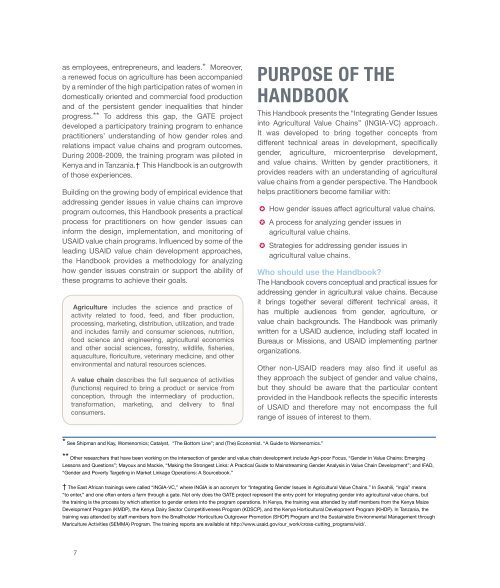promoting gender equitable opportunities in agricultural ... - weman
promoting gender equitable opportunities in agricultural ... - weman
promoting gender equitable opportunities in agricultural ... - weman
You also want an ePaper? Increase the reach of your titles
YUMPU automatically turns print PDFs into web optimized ePapers that Google loves.
as employees, entrepreneurs, and leaders.* Moreover,a renewed focus on agriculture has been accompaniedby a rem<strong>in</strong>der of the high participation rates of women <strong>in</strong>domestically oriented and commercial food productionand of the persistent <strong>gender</strong> <strong>in</strong>equalities that h<strong>in</strong>derprogress.** To address this gap, the GATE projectdeveloped a participatory tra<strong>in</strong><strong>in</strong>g program to enhancepractitioners’ understand<strong>in</strong>g of how <strong>gender</strong> roles andrelations impact value cha<strong>in</strong>s and program outcomes.Dur<strong>in</strong>g 2008-2009, the tra<strong>in</strong><strong>in</strong>g program was piloted <strong>in</strong>Kenya and <strong>in</strong> Tanzania.† This Handbook is an outgrowthof those experiences.Build<strong>in</strong>g on the grow<strong>in</strong>g body of empirical evidence thataddress<strong>in</strong>g <strong>gender</strong> issues <strong>in</strong> value cha<strong>in</strong>s can improveprogram outcomes, this Handbook presents a practicalprocess for practitioners on how <strong>gender</strong> issues can<strong>in</strong>form the design, implementation, and monitor<strong>in</strong>g ofUSAID value cha<strong>in</strong> programs. Influenced by some of thelead<strong>in</strong>g USAID value cha<strong>in</strong> development approaches,the Handbook provides a methodology for analyz<strong>in</strong>ghow <strong>gender</strong> issues constra<strong>in</strong> or support the ability ofthese programs to achieve their goals.Agriculture <strong>in</strong>cludes the science and practice ofactivity related to food, feed, and fiber production,process<strong>in</strong>g, market<strong>in</strong>g, distribution, utilization, and tradeand <strong>in</strong>cludes family and consumer sciences, nutrition,food science and eng<strong>in</strong>eer<strong>in</strong>g, <strong>agricultural</strong> economicsand other social sciences, forestry, wildlife, fisheries,aquaculture, floriculture, veter<strong>in</strong>ary medic<strong>in</strong>e, and otherenvironmental and natural resources sciences.A value cha<strong>in</strong> describes the full sequence of activities(functions) required to br<strong>in</strong>g a product or service fromconception, through the <strong>in</strong>termediary of production,transformation, market<strong>in</strong>g, and delivery to f<strong>in</strong>alconsumers.PURPOSE OF THEHANDBOOKThis Handbook presents the “Integrat<strong>in</strong>g Gender Issues<strong>in</strong>to Agricultural Value Cha<strong>in</strong>s” (INGIA-VC) approach.It was developed to br<strong>in</strong>g together concepts fromdifferent technical areas <strong>in</strong> development, specifically<strong>gender</strong>, agriculture, microenterprise development,and value cha<strong>in</strong>s. Written by <strong>gender</strong> practitioners, itprovides readers with an understand<strong>in</strong>g of <strong>agricultural</strong>value cha<strong>in</strong>s from a <strong>gender</strong> perspective. The Handbookhelps practitioners become familiar with:✪✪ How <strong>gender</strong> issues affect <strong>agricultural</strong> value cha<strong>in</strong>s.✪✪ A process for analyz<strong>in</strong>g <strong>gender</strong> issues <strong>in</strong><strong>agricultural</strong> value cha<strong>in</strong>s.✪✪ Strategies for address<strong>in</strong>g <strong>gender</strong> issues <strong>in</strong><strong>agricultural</strong> value cha<strong>in</strong>s.Who should use the Handbook?The Handbook covers conceptual and practical issues foraddress<strong>in</strong>g <strong>gender</strong> <strong>in</strong> <strong>agricultural</strong> value cha<strong>in</strong>s. Becauseit br<strong>in</strong>gs together several different technical areas, ithas multiple audiences from <strong>gender</strong>, agriculture, orvalue cha<strong>in</strong> backgrounds. The Handbook was primarilywritten for a USAID audience, <strong>in</strong>clud<strong>in</strong>g staff located <strong>in</strong>Bureaus or Missions, and USAID implement<strong>in</strong>g partnerorganizations.Other non-USAID readers may also f<strong>in</strong>d it useful asthey approach the subject of <strong>gender</strong> and value cha<strong>in</strong>s,but they should be aware that the particular contentprovided <strong>in</strong> the Handbook reflects the specific <strong>in</strong>terestsof USAID and therefore may not encompass the fullrange of issues of <strong>in</strong>terest to them.* See Shipman and Kay, Womenomics; Catalyst, “The Bottom L<strong>in</strong>e”; and (The) Economist. “A Guide to Womenomics.”** Other researchers that have been work<strong>in</strong>g on the <strong>in</strong>tersection of <strong>gender</strong> and value cha<strong>in</strong> development <strong>in</strong>clude Agri-poor Focus, “Gender <strong>in</strong> Value Cha<strong>in</strong>s: Emerg<strong>in</strong>gLessons and Questions”; Mayoux and Mackie, “Mak<strong>in</strong>g the Strongest L<strong>in</strong>ks: A Practical Guide to Ma<strong>in</strong>stream<strong>in</strong>g Gender Analysis <strong>in</strong> Value Cha<strong>in</strong> Development”; and IFAD,“Gender and Poverty Target<strong>in</strong>g <strong>in</strong> Market L<strong>in</strong>kage Operations: A Sourcebook.”† The East African tra<strong>in</strong><strong>in</strong>gs were called “INGIA-VC,” where INGIA is an acronym for “Integrat<strong>in</strong>g Gender Issues <strong>in</strong> Agricultural Value Cha<strong>in</strong>s.” In Swahili, “<strong>in</strong>gia” means“to enter,” and one often enters a farm through a gate. Not only does the GATE project represent the entry po<strong>in</strong>t for <strong>in</strong>tegrat<strong>in</strong>g <strong>gender</strong> <strong>in</strong>to <strong>agricultural</strong> value cha<strong>in</strong>s, butthe tra<strong>in</strong><strong>in</strong>g is the process by which attention to <strong>gender</strong> enters <strong>in</strong>to the program operations. In Kenya, the tra<strong>in</strong><strong>in</strong>g was attended by staff members from the Kenya MaizeDevelopment Program (KMDP), the Kenya Dairy Sector Competitiveness Program (KDSCP), and the Kenya Horticultural Development Program (KHDP). In Tanzania, thetra<strong>in</strong><strong>in</strong>g was attended by staff members from the Smallholder Horticulture Outgrower Promotion (SHOP) Program and the Susta<strong>in</strong>able Environmental Management throughMariculture Activities (SEMMA) Program. The tra<strong>in</strong><strong>in</strong>g reports are available at http://www.usaid.gov/our_work/cross-cutt<strong>in</strong>g_programs/wid/.7










